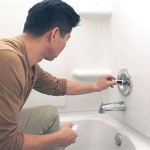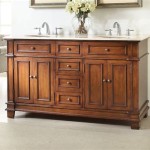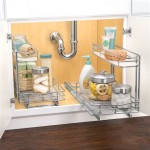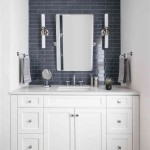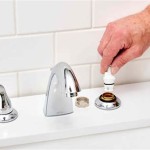Unique Bathroom Backsplash Ideas
The bathroom backsplash, often an overlooked element in bathroom design, presents a significant opportunity to infuse personality and style into a space. While functionality—protecting walls from water damage—remains paramount, the backsplash can also serve as a focal point, enhancing the overall aesthetic of the bathroom. Exploring unique backsplash ideas allows homeowners and designers to move beyond traditional tile options and experiment with diverse materials, patterns, and textures, thereby creating bathrooms that are both practical and visually compelling.
Selecting the optimal backsplash requires careful consideration of factors such as the bathroom's existing décor, budget constraints, and personal preferences. Elements like color, material, and pattern should harmonize with the rest of the bathroom's design scheme. Furthermore, the chosen material needs to be suitable for the bathroom environment, capable of withstanding moisture and cleaning agents. The subsequent sections will delve into several unique backsplash ideas, providing insights into their respective advantages and considerations.
Elevated Use of Natural Stone Backsplashes
Natural stone, such as marble, granite, and slate, offers an unparalleled sense of luxury and sophistication to a bathroom backsplash. Each stone slab possesses unique veining and color variations, ensuring a one-of-a-kind design. Using large slabs of stone minimizes grout lines, creating a seamless and visually cohesive surface. Marble, known for its elegant appearance, can be particularly effective in creating a spa-like atmosphere. Granite, with its durability and resistance to staining, is a practical choice for high-use areas. Slate, with its textured surface and earthy tones, can add a rustic or contemporary touch.
The installation of natural stone backsplashes often requires professional expertise due to the weight and fragility of the materials. Proper sealing is essential to protect the stone from water damage and staining. While natural stone tends to be more expensive than other backsplash materials, the long-term value and aesthetic appeal often justify the investment. For a more budget-friendly option, consider using stone tiles rather than large slabs. There are various styles and patterns such as stacked stone or mosaic stone design.
Beyond the common selections, consider travertine for its porous texture and earthy tones or limestone for a softer, more muted aesthetic. When incorporating natural stone, lighting plays a crucial role in accentuating its inherent beauty. Strategically positioned lighting can highlight the veining and textures, creating a dynamic and visually engaging backsplash. The addition of natural stone features significantly improves the luxurious feel and increases property values.
Bold and Geometrical Tile Designs
Geometric tiles are a versatile option for creating eye-catching bathroom backsplashes. These tiles come in various shapes, sizes, and colors, allowing for endless design possibilities. Hexagon tiles, for example, can be arranged in intricate patterns to create a visually stimulating backsplash. Subway tiles, laid in unconventional patterns like herringbone or vertical stacks, offer a modern twist on a classic design. Mosaic tiles, composed of small pieces of glass, ceramic, or stone, can be used to create intricate murals or abstract patterns. The selection of grout color significantly impacts the overall appearance of the backsplash. A contrasting grout color can emphasize the tile pattern, while a matching grout color creates a more seamless look.
When selecting geometric tiles, consider the scale of the pattern in relation to the size of the bathroom. Large-scale patterns can overwhelm smaller bathrooms, while smaller patterns may get lost in larger spaces. Experimenting with different tile layouts and color combinations is essential to achieve the desired aesthetic. Some popular geometric tile patterns include chevron, basketweave, and pinwheel. Consider using textured tiles to add depth and dimension to the backsplash.
The use of bright colors or metallic finishes can further enhance the visual impact of geometric tile backsplashes. However, it is important to maintain a sense of balance and avoid overwhelming the space. Pairing bold geometric tiles with neutral-colored walls and fixtures can create a harmonious and visually appealing bathroom. Consider using software or online tools to visualize different tile patterns and color combinations before making a final decision. Ultimately, the goal is to create a backsplash that reflects personal style and complements the overall design of the bathroom.
Unexpected Materials for Unique Visuals
Moving beyond traditional tile opens up a world of creative possibilities for bathroom backsplashes. Glass tiles, for instance, offer a sleek and modern look, and their reflective surface can brighten up small bathrooms. Reclaimed wood, with its rustic charm and unique imperfections, can create a warm and inviting atmosphere. Metal tiles, such as stainless steel or copper, add an industrial edge to the bathroom design. Using mirrors as a backsplash is something that may create a unique look to the bathroom design, making the space larger.
When incorporating unconventional materials, careful consideration must be given to their suitability for the bathroom environment. Wood, for example, needs to be properly sealed to prevent water damage and mold growth. Metal tiles may require special cleaning agents to maintain their shine and prevent corrosion. Glass tiles are relatively easy to clean and maintain, but they can be prone to scratches. Regardless of the chosen material, proper installation is crucial to ensure a long-lasting and visually appealing backsplash.
Consider using materials such as concrete for a modern industrial look, or even salvaged architectural elements like vintage window frames. Chalkboard paint provides a fun and interactive backsplash option, allowing for customized messages and artwork. Cork, with its natural texture and sound-dampening properties, is another unique and eco-friendly choice. When experimenting with unconventional materials, prioritize durability, water resistance, and ease of maintenance. Combining different materials can create a visually stunning and personalized backsplash that reflects individual style and creativity.
Exploring Texture and Dimension
Moving beyond flat surfaces, adding texture and dimension to a bathroom backsplash can dramatically enhance its visual appeal. 3D tiles, with their raised patterns and sculptural forms, create a dynamic and tactile surface. Textured glass tiles, with their rippled or frosted finishes, add depth and visual interest. Using a combination of different tile thicknesses and sizes can create a layered effect that is both visually striking and tactilely engaging.
When incorporating texture and dimension, lighting plays a crucial role in accentuating the surface details. Strategically positioned lighting can highlight the variations in depth and create dramatic shadows. Consider using accent lighting to draw attention to specific areas of the backsplash. The choice of grout color can also impact the overall appearance of the textured backsplash. A contrasting grout color can emphasize the three-dimensional effect, while a matching grout color creates a more subtle and seamless look.
Consider using natural materials with inherent texture, such as river rock or pebbles, to create a rustic and organic backsplash. Incorporating elements like seashells or glass beads can add a touch of whimsy and personality. Experiment with different installation techniques, such as stacking tiles vertically or horizontally to create unique patterns. Ultimately, the goal is to create a backsplash that is both visually appealing and tactilely engaging, transforming the bathroom into a sensory experience. Consider using textured wallpaper or even concrete panels.
The Allure of Mirrored Backsplashes
A mirrored backsplash offers a unique approach to bathroom design, providing both aesthetic and functional benefits. Mirrors create the illusion of a larger space, making them particularly effective in small bathrooms. They also enhance the brightness of the room by reflecting light. A mirrored backsplash can be a single large sheet of glass or can be composed of individual mirror tiles, each offering a different aesthetic.
When considering a mirrored backsplash, it is essential to choose high-quality mirrors that are resistant to moisture and scratches. Proper installation is crucial to ensure a seamless and long-lasting finish. Regularly cleaning the mirrored backsplash is necessary to maintain its reflective properties and prevent the build-up of water spots or soap scum. Consider adding a decorative frame around the mirror to further enhance its visual appeal.
Tinted mirrors, such as bronze or smoked glass, can add a touch of sophistication and create a warmer ambiance. Antique mirrors, with their aged patina, offer a vintage and characterful look. Combining mirrored tiles with other materials, such as glass or stone, can create a visually interesting and dynamic backsplash. Be mindful of the reflections created by the mirrored backsplash, ensuring that they do not create unwanted distractions or visual clutter. A mirrored backsplash can improve the style and functionality of the bathroom by increasing the feeling of space and light.
Incorporating Art and Murals
Transforming the bathroom backsplash into a canvas for artistic expression is a unique and personalized approach. Hand-painted tiles, custom mosaics, or even waterproof murals can create a one-of-a-kind focal point. Collaborating with an artist to create a bespoke backsplash ensures that it perfectly reflects individual style and preferences. Digital printing technology allows for the creation of high-resolution murals on various materials, including glass, ceramic, and porcelain.
When incorporating art into the backsplash, it is essential to choose materials and techniques that are suitable for the bathroom environment. The artwork needs to be durable, water-resistant, and easy to clean. Consider using epoxy grout to seal the tiles and prevent water damage. Proper lighting is crucial to showcase the artwork and enhance its visual impact. Strategically positioned lighting can highlight the colors, textures, and details of the backsplash.
Consider using temporary art installations, such as removable wallpaper or framed prints, to allow for easy changes and updates. Incorporating natural elements, such as pressed flowers or leaves, into the backsplash can create a unique and organic aesthetic. Experiment with different artistic styles, such as abstract expressionism, realism, or pop art, to create a backsplash that reflects individual tastes and personality. Ultimately, the goal is to create a backsplash that is not only functional but also a work of art that enhances the overall aesthetic of the bathroom. This adds character to the room and a unique artistic touch.

62 Bathroom Backsplash Ideas For A Stylish Makeover White Subway Tile Vanity Designs

Brilliant Bathroom Backsplash Ideas Family Handyman

23 Bathroom Backsplash Ideas Sebring Design Build Inspiration Decor Remodel Designs Interior

47 Modern Bathroom Backsplash Sleek Plain Tile Designs

78 Very Small Bathroom Ideas Clever Solutions Spaces

62 Bathroom Backsplash Ideas For A Stylish Makeover Vanity Amazing Bathrooms Simple

24 Ideas For A Creative Bathroom Backsplash

15 Bathroom Backsplash Ideas

Small Bathroom Remodel Easy Diy Tile Backsplash Engineer Your Space

Bathroom Backsplash Ideas And Inspiration Hunker
Related Posts
